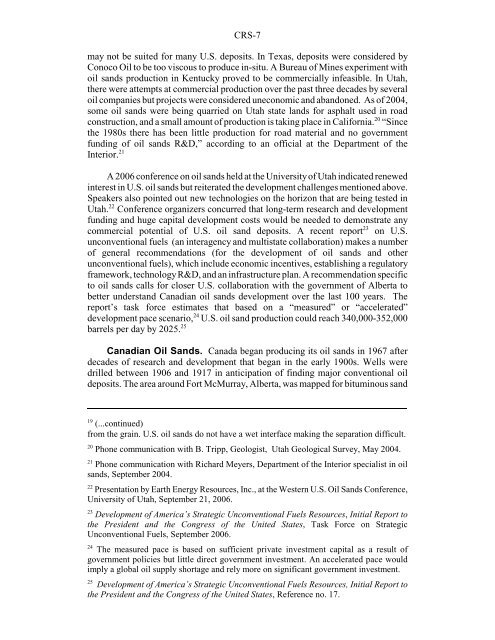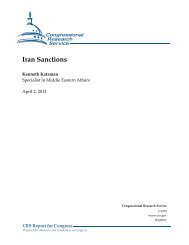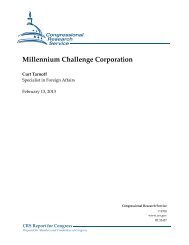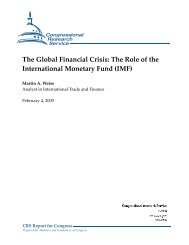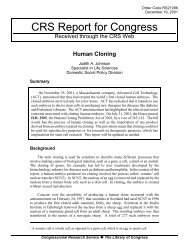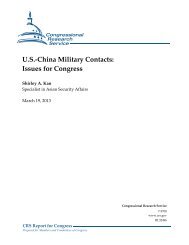North American Oil Sands: History of ... - The Air University
North American Oil Sands: History of ... - The Air University
North American Oil Sands: History of ... - The Air University
Create successful ePaper yourself
Turn your PDF publications into a flip-book with our unique Google optimized e-Paper software.
CRS-7<br />
may not be suited for many U.S. deposits. In Texas, deposits were considered by<br />
Conoco <strong>Oil</strong> to be too viscous to produce in-situ. A Bureau <strong>of</strong> Mines experiment with<br />
oil sands production in Kentucky proved to be commercially infeasible. In Utah,<br />
there were attempts at commercial production over the past three decades by several<br />
oil companies but projects were considered uneconomic and abandoned. As <strong>of</strong> 2004,<br />
some oil sands were being quarried on Utah state lands for asphalt used in road<br />
construction, and a small amount <strong>of</strong> production is taking place in California. 20 “Since<br />
the 1980s there has been little production for road material and no government<br />
funding <strong>of</strong> oil sands R&D,” according to an <strong>of</strong>ficial at the Department <strong>of</strong> the<br />
Interior. 21<br />
A 2006 conference on oil sands held at the <strong>University</strong> <strong>of</strong> Utah indicated renewed<br />
interest in U.S. oil sands but reiterated the development challenges mentioned above.<br />
Speakers also pointed out new technologies on the horizon that are being tested in<br />
Utah. 22 Conference organizers concurred that long-term research and development<br />
funding and huge capital development costs would be needed to demonstrate any<br />
commercial potential <strong>of</strong> U.S. oil sand deposits. A recent report 23 on U.S.<br />
unconventional fuels (an interagency and multistate collaboration) makes a number<br />
<strong>of</strong> general recommendations (for the development <strong>of</strong> oil sands and other<br />
unconventional fuels), which include economic incentives, establishing a regulatory<br />
framework, technology R&D, and an infrastructure plan. A recommendation specific<br />
to oil sands calls for closer U.S. collaboration with the government <strong>of</strong> Alberta to<br />
better understand Canadian oil sands development over the last 100 years. <strong>The</strong><br />
report’s task force estimates that based on a “measured” or “accelerated”<br />
development pace scenario, 24 U.S. oil sand production could reach 340,000-352,000<br />
barrels per day by 2025. 25<br />
Canadian <strong>Oil</strong> <strong>Sands</strong>. Canada began producing its oil sands in 1967 after<br />
decades <strong>of</strong> research and development that began in the early 1900s. Wells were<br />
drilled between 1906 and 1917 in anticipation <strong>of</strong> finding major conventional oil<br />
deposits. <strong>The</strong> area around Fort McMurray, Alberta, was mapped for bituminous sand<br />
19 (...continued)<br />
from the grain. U.S. oil sands do not have a wet interface making the separation difficult.<br />
20 Phone communication with B. Tripp, Geologist, Utah Geological Survey, May 2004.<br />
21 Phone communication with Richard Meyers, Department <strong>of</strong> the Interior specialist in oil<br />
sands, September 2004.<br />
22 Presentation by Earth Energy Resources, Inc., at the Western U.S. <strong>Oil</strong> <strong>Sands</strong> Conference,<br />
<strong>University</strong> <strong>of</strong> Utah, September 21, 2006.<br />
23 Development <strong>of</strong> America’s Strategic Unconventional Fuels Resources, Initial Report to<br />
the President and the Congress <strong>of</strong> the United States, Task Force on Strategic<br />
Unconventional Fuels, September 2006.<br />
24 <strong>The</strong> measured pace is based on sufficient private investment capital as a result <strong>of</strong><br />
government policies but little direct government investment. An accelerated pace would<br />
imply a global oil supply shortage and rely more on significant government investment.<br />
25 Development <strong>of</strong> America’s Strategic Unconventional Fuels Resources, Initial Report to<br />
the President and the Congress <strong>of</strong> the United States, Reference no. 17.


